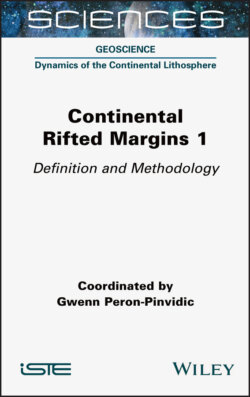Читать книгу Continental Rifted Margins 1 - Gwenn Peron-Pinvidic - Страница 33
1.3.2.4. Metamorphic core complexes
ОглавлениеWhen a region is submitted to large amounts of extension, mid- to lower-crustal levels can be dragged out from beneath the brittle fractured upper crust. The resulting dome-shaped structure is called a metamorphic core complex (Whitney et al. 2014; Brun et al. 2018). Typically, the exhumation process includes a concave-downward detachment fault, exhibiting ductile deformation in the footwall with amphibolite- to greenschist-facies metamorphism, and brittle deformation in the hanging wall with high-angle normal faults (HANFs) and tilted unmetamorphosed crustal blocks. These HANFs often merge with the detachment fault at depth (Figure 1.21). Depending on the lithospheric parameters (e.g. thermal state, extensional rate), the core complex may be capped by a shear zone rather than a simple fault plane, with brittle to ductile deformation features. Deformation products associated with such structures are multiple and can include breccias, mylonites and phyllonites. Metamorphic core complexes are encountered in various extensional settings and are often interpreted in seismic data of rifted continental margins.
Figure 1.21. Illustration of a metamorphic core complex
CONTINUATION OF CAPTION FOR FIGURE 1.21.– a) Schematic representation of a metamorphic core complex with a window of exhumed basement capped by a detachment fault and overriding tilted blocks flanked by high-angle normal faults (HANF) (source: modified from Osmundsen et al. 2003 and Fossen 2010); b) field example with map, sections and photos from the Western Gneiss Region in southwestern Norway (A, B) and focus on the Gulen Metamorphic core complex (MCC) with outcrop photos (right-hand inset photos). NSDZ: Nordfjord-Sogn detachment zone. BASZ: Bergen Arc Shear Zone (source: from Wiest et al. 2019) and c) seismic reflection profile (TGS) from the Trøndelag Platform; in time (s-twtt), without (top) and with interpretation (bottom) (location on the map inset on the right) (source: from Peron-Pinvidic and Osmundsen 2020).
The rolling-hinge model for metamorphic core complexes (Buck 1988; Wernicke and Axen 1988; Lavier et al. 1999) includes the definition of a large-scale concave-downward detachment fault which evolves from high to low angles as the footwall flexes upward during unroofing from below the hanging wall (Figure 1.22). This model is often used to explain basement exhumation in continental rifted margin and oceanic ridge studies. Reston and McDermott (2011) further refined the rolling-hinge concept by having successive detachment faults at the rift switch polarity and thus cut into their predecessor’s footwall (the so-called “flipping” or “flip-flop” model). The resulting alternating dip orientation of the main detachment then provides an elegant model to explain how extensive surfaces of symmetric exhumed basement can be generated by an asymmetric tectonic structure (for further information, see Chapter 2).
